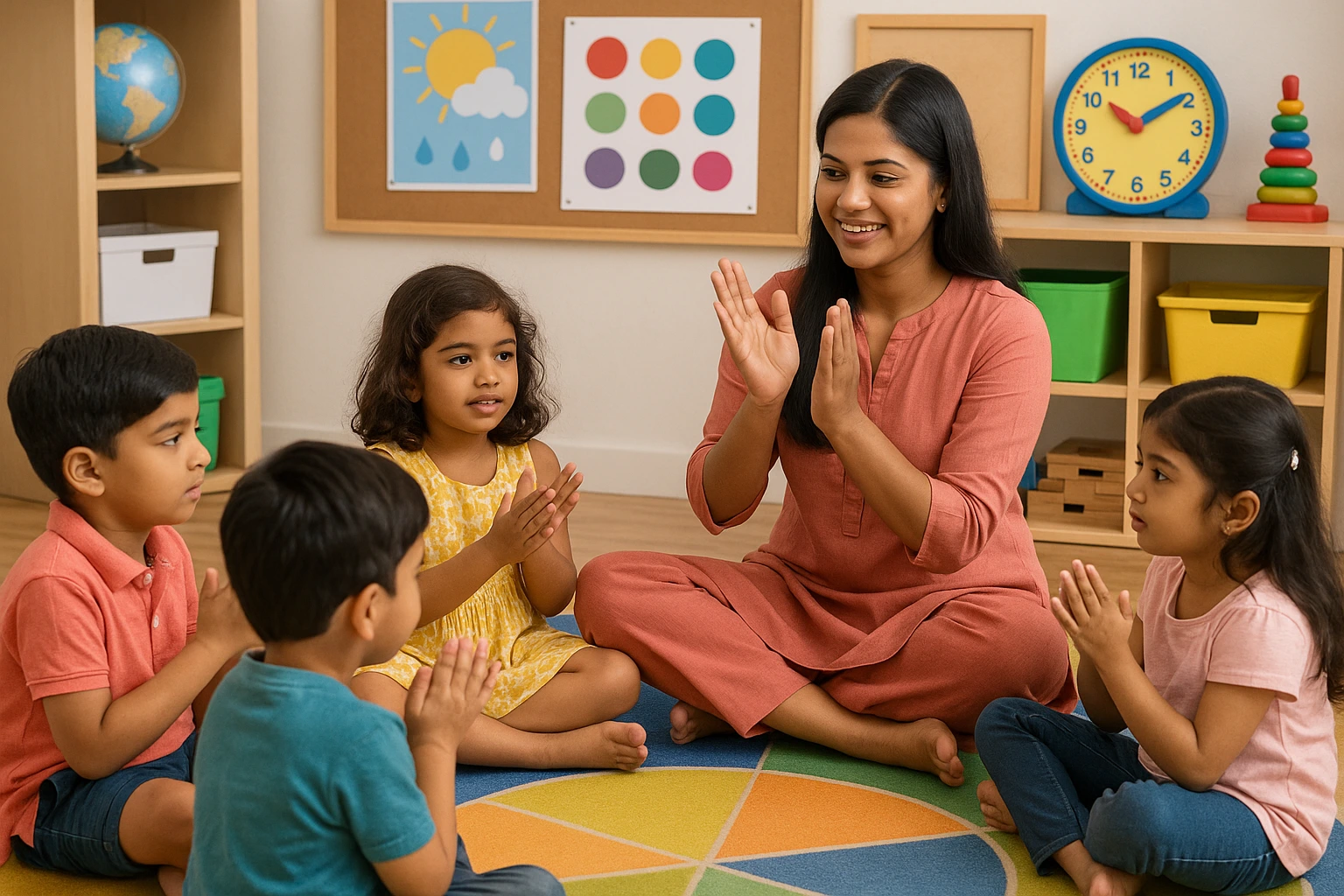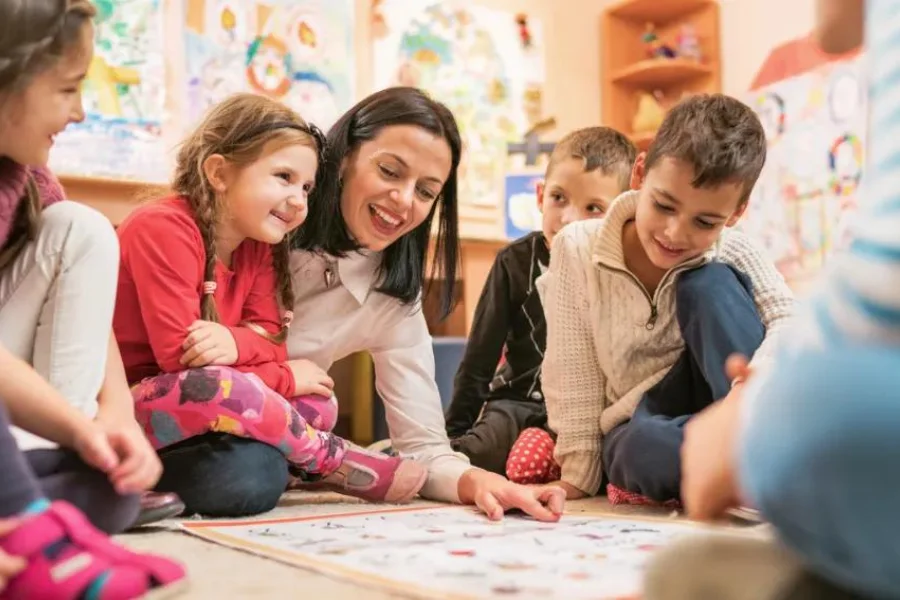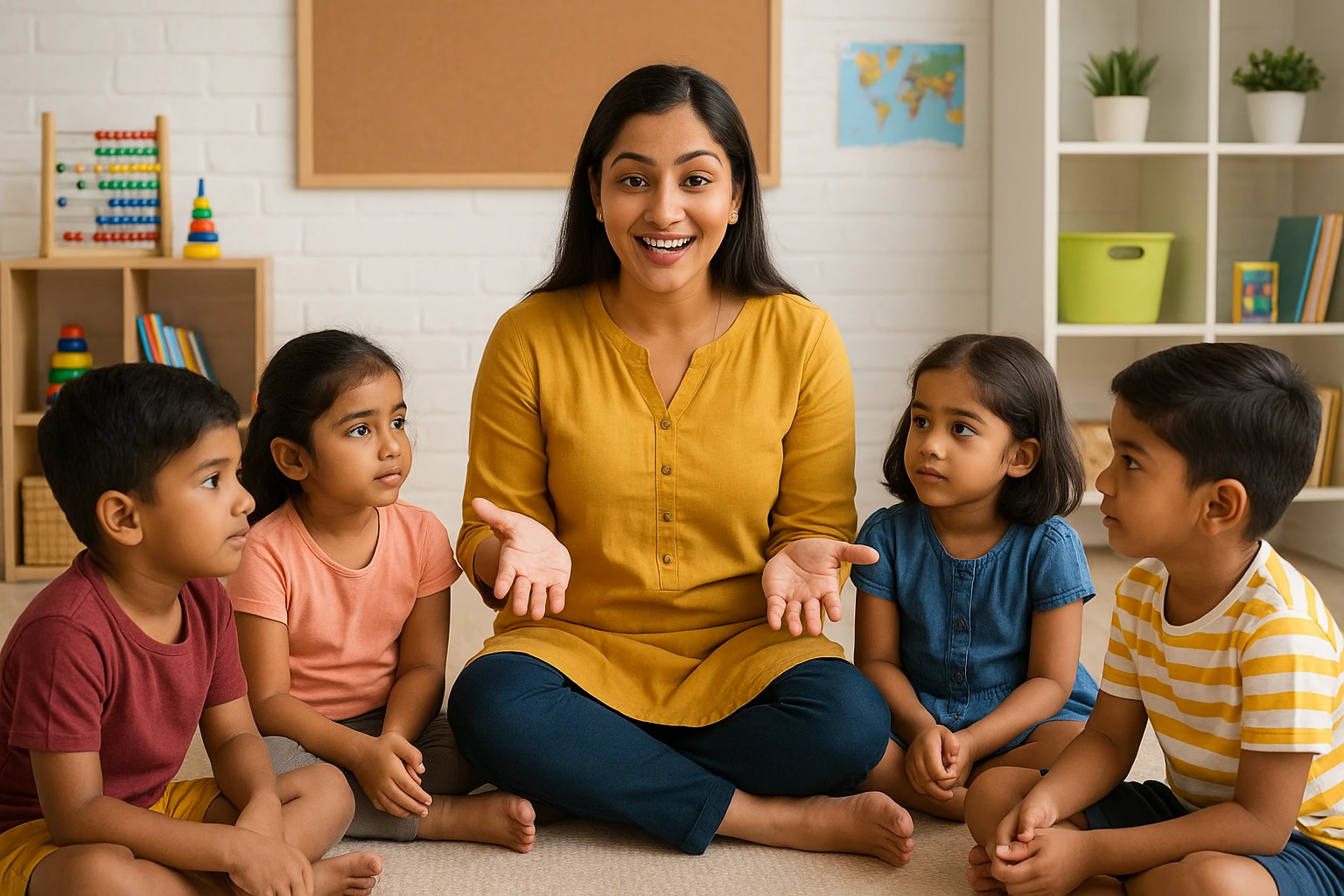What is Circle Time for Kindergarten?
What is Circle Time for Kindergarten?
Circle Time for Kindergarten is a part of learning routine, which is conducted at the start of class. It is a fun and structured activity where all the students sit together in a circle with teacher being in the center.
The purpose of circle time is to connect all students together in a organised sitting, foster sharing, collaboration and develop listening & social skills.
In circle time the whole discuss about the weather outside, days of week or teachers may convey stories and ask children to share their thoughts.
Circle Time for Kindergarten sets the tone for the day, where children understand what is expected of them.
Table of Content
How To Do Circle Time in Kindergarten?
Leading a Circle Time for Kindergarten children is a fun activity, when the right and meaningful steps are followed. This activity helps build a sense of community in a respectful environment.
Teachers must thoughtfully plan circle time activities to make this daily classroom routine engaging and impactful.
Here’s how to effectively conduct Circle Time for Kindergarten:
Set a Clear Routine:
Keep the timing consistent each day. Start with a signal like a song or chime to let children know it’s time for Circle Time for Kindergarten. This builds a sense of security and predictability.
Arrange the Space:
Consider a large open circle space where all students can accommodate easily and can see the each other. This arrangement encourages group participation.
Include Daily Activities:
Start with greetings, followed by calendar checks, weather talks, and the day’s schedule. This routine during Circle Time for Kindergarten helps children prepare mentally for the day.
Use Visual Aids:
To make Circle Time for Kindergarten interactive and long-lasting. Use tools that support cognitive learning such as flashcards, charts, calendars and weather boards.
Keep It Short and Engaging:
A circle time should be extending to only 10–15 minutes with simple storytelling and songs. A lengthy activity will distract children and shift their focus.
Encourage Participation:
To boast communication and confidence of students, Use open-ended questions that allow children to share their thoughts and understanding.
Smooth Transition:
End Circle Time with a calm activity or a meaningful song. This helps to shift further with the classroom routine.
By following these steps, Circle Time for Kindergarten becomes a energy boasting activity of the day, making children focused for rest of the routine. It strengthens classroom relationships and builds a strong learning foundation.
Click Here, to download the brochure of Teacher Training Course!
Call or Whatsapp on +919869546913 / +919869866277, for details of Teacher Training Course!

What are the Rules of Circle Time?
Circle Time for Kindergarten is purposeful activity that provides students opportunities to learn about organized routines and develop social skills. Circle time fosters on certain rules which makes it a impactful part of learning.
Let’s understand the format and rules of Circle Time for Kindergarten:
- Sit in a Circle: The very first and apparent rule of circle time is children are required to sit in a circle so everyone can see and interact with each other including teacher. This supports equal participation.
- Use Listening Ears: Paying attention when others speak is a core rule of Circle Time for Kindergarten. It encourages respect and helps children focus.
- Raise Hands to Speak: Students are taught to raise their hands and wait for their turn. This creates positive learning and avoid interruptions.
- Keep Hands and Feet to Self: Physical boundaries are emphasized to keep Circle Time calm and comfortable for all children.
- Speak Kindly: By sitting close to each other, children are encouraged to speak kindly.
- Follow Teacher’s Signals: Children should follow teachers signs like clapping hands, or other cues during Circle Time for Kindergarten. This increases focus and attention of students
- Stay Seated: This structured sitting arrangement, eliminates unnecessary walk out of students. Children are encouraged to sit and participate proactively without being distracted.
By following these Rules Teachers can make circle time a successful activity. Such rules are designed to be easy and organized, that provides opportunities of active participation to children. This structured following maintain order and helps to understand classroom behaviour.
Click Here, to download the brochure of Teacher Training Course!
Call or Whatsapp on +919869546913 / +919869866277, for details of Teacher Training Course!

Source: istockphoto
What Children Learn from Circle Time
In kindergarten learning, circle time is the crucial activity that build social skills and support development stages of students. Children learn to engage and interact with each other in Circle Time for Kindergarten. It aims to develop confidence and public speaking in students.
Here is the elaboration of essential learning that children gain from Circle Time for Kindergarten:
Listening Skills:
Children learn to listen attentively when teachers or other students speak. It builds patience and concentration.
Turn-Taking:
Circle Time for Kindergarten encourages children to wait for their turn and then speak. It builds patience to work in team without encountering chaos.
Following Instructions:
With circle time children to follow teachers instructions and directions through group tasks. It creates organization and responsible behaviour.
Emotional Expression:
Children share their thoughts, and express feelings in circle time. This supports emotional expression and of students and help them understand each other.
Social Interaction:
Circle time are the best approach to create social interaction among students, here children share their thoughts and connect interests with others.
Basic Concepts:
Circle Time for Kindergarten, greatly supports early literacy and math. With the help of stories, teachers explain the basic concepts of language and numeracy .
Group Belonging:
Sitting together in a circle, builds a sense of community and togetherness. Through circle time, friendship develop and children become compassionate.
Routine and Structure:
Circle Time for Kindergarten enhances organization and routine. Children become aware of predictability which makes focused.
Children gain foundational life skills in a structured setting with Circle Time activities. The consistent learning process help students grow in multiple developing areas with engaging activities.
Click Here, to download the brochure of Teacher Training Course!
Call or Whatsapp on +919869546913 / +919869866277, for details of Teacher Training Course!

Some Examples of Circle Time Activities
Circle Time for Kindergarten is a great way to develop social skills for children by forming them in one group. Activities during this time are designed to be supportive of early learning goals, interactive, and engaging.
Let’s see some examples of circle time activities for Kindergarten:
Hello Songs and Name Games
Start Circle Time for Kindergarten with a cheerful hello song or a name game. This encourages participation and helps children learn each other’s names.
Discussion on days and weather
Discuss the date, day of the week, and current weather. This supports language development and early understanding of time and seasons during Circle Time for Kindergarten.
Story Sharing
Here teachers read story and ask students to share their input about the story. This is effective in building communication and listening skills.
Show and Tell
This fun activity involves children’s speaking one by one. They bring a favourite object from home and talk about it for a minute. This builds vocabulary, sentence creation and communication.
Movement Games
Simple games are incorporated to improve coordination, movement, active participation and engagement.
Each of these activities of Circle Time for Kindergarten strengthens and support every developing needs of young children from language to emotional. Such circle time activities facilitates children to attain inclusive growth in a structured environment.
Enrolling in the ECCEd Course by Vidhyanidhi Education Society (Govt. Regd.) can be a valuable step. It helps to gain deeper insights into of creating an interactive circle time, classroom management strategies and child development methods.
With expert guidance from Vidhyanidhi Education Society (Govt. Regd.) faculty and flexible learning options, the ECCEd Course helps shape confident and capable early years educators.
Shape young minds with skill—join Vidhyanidhi’s Teacher Training Course today!
Click Here, to download the brochure of Teacher Training Course!
Call or Whatsapp on +919869546913 / +919869866277, for details of Teacher Training Course!
FAQs
What is Another Name for Circle Time?
Another name for Circle Time is Morning Meeting.
What Age to Start Circle Time?
The right time to start circle time is when children start their kindergarten learning around the age of 2.5 or 3 years.





